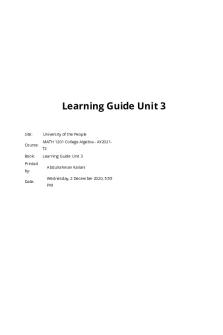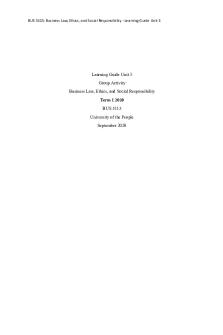BUS 5115 Business Law, Ethics, and Social Responsibility - Learning Guide Unit 3 - Group PDF

| Title | BUS 5115 Business Law, Ethics, and Social Responsibility - Learning Guide Unit 3 - Group |
|---|---|
| Author | Howard Khan |
| Course | Business Law, Ethics and Social Responsibility |
| Institution | University of the People |
| Pages | 7 |
| File Size | 163.3 KB |
| File Type | |
| Total Downloads | 687 |
| Total Views | 861 |
Summary
Learning Guide Unit 3 Group Activity Business Law, Ethics, and Social Responsibility Term 1 2020 BUS 5115 University of the People September 2020Learning Guide Unit 3 Group Activity - Preliminary Work The ability to work in teams is critical to a successful business career. In larger corporations, q...
Description
BUS 5115: Business Law, Ethics, and Social Responsibility - Learning Guide Unit 3
Learning Guide Unit 3 Group Activity Business Law, Ethics, and Social Responsibility Term 1 2020 BUS 5115 University of the People September 2020
BUS 5115: Business Law, Ethics, and Social Responsibility - Learning Guide Unit 3
Learning Guide Unit 3 Group Activity - Preliminary Work The ability to work in teams is critical to a successful business career. In larger corporations, quality circles at all levels of management include experts from different specialty areas (e.g., a finance person, a marketing person, an engineer, and a lawyer might all work together on developing the next year's model of a car, or of an umbrella. In smaller firms, the partners may have different strengths, so work together to satisfy clients, e.g., the money person might work with the design person, and the personnel manager to decide where they should develop the next housing construction. Whatever the case, working effectively as a member of a work group or team is an essential skill for MBA graduates to have in their toolboxes. Beginning in Unit 4 you will be placed into a team and required to work together for the next few units to develop a Code of Conduct. This unit requires that you do some preliminary work before beginning the teamwork. Working in your teams you will act as if you have been hired as consultants to help the UoPeople Human Resources department by creating a Code of Conduct to include in their employee ethics training and in the Employee Handbook. Familiarize yourself with all parts and types of Codes of Conduct, and reflect on what makes the most sense to include in a Code of Conduct for the University of the People faculty and staff. The final Code of Conduct will not be due until the end of Unit 6, but you should consider what should be included (or not) in such a Code of Conduct before meeting with your team and engaging in the process of creating the finished project during Units 4-6. This preliminary work will allow you to begin immediately by negotiating the parts of the Code of Conduct and assigning the work to the individual members.
BUS 5115: Business Law, Ethics, and Social Responsibility - Learning Guide Unit 3
Your team will be submitting a fully articulated Code of Conduct (you are encouraged to locate examples of Codes of Conduct, in addition to other research necessary to complete this task.) Your team will also be required to write a one-page rationale, at the beginning of the paper, explaining what components you decided to include, as well as what you decided to leave out and why. It will be important for someone in your group to capture these decisions/negotiations as the group works together. To prepare for this activity, read and take notes on the following. Review the requirements in the BUS 5115 Group Project Overview. Review the Ethics & Compliance Initiative's Code of Conduct toolkit. Read through the sections (available on the right in the blue box) paying particular attention to these:
Definition of Values
Why Have a Code of Conduct?
Code Construction and Content
Common Code Provisions
Ten Styling Tips for Writing an Effective Code of Conduct Read the guidelines below for writing a Code of Conduct:
Insights for Writing a Code of Ethics
Creating a Company Code of Ethics Writing a Code of Conduct requires understanding the values of a business. You will
want to review the University of the People website to understand the organization better:
UoPeople: Mission & Values
BUS 5115: Business Law, Ethics, and Social Responsibility - Learning Guide Unit 3
UoPeople: About Us
BUS 5115: Business Law, Ethics, and Social Responsibility - Learning Guide Unit 3
Learning Guide Unit 3 Annotated Resource List Below is an annotated APA list of all the reading and other resources found within this unit's learning content.
Associated Press (2014, Mar 4). Chevron wins US legal battle against Ecuadorian court’s $9bn ruling. The Guardian. Retrieved from: http://www.theguardian.com/business/2014/mar/04/chevron-ecuador-court-rulingrainforest-billions
This article uses Chevron's environmental issues in Ecuador to show how environmental cases can drag on with uncertain futures.
Business Ethics (2012). Chapter 14: The green office: Economics and the environment. Retrieved from: http://2012books.lardbucket.org/books/business-ethics/index.html
This chapter explores the multiple relations linking business, the environment, and environmental protection.
CTGN America. (2019. April 6). A 25-year legal battle over oil pollution in Ecuador’s Amazon rain forest. Made available through: http://www.kaltura.com/tiny/iy0cc
A 25-year legal battle over oil pollution in Ecuador’s Amazon rain forest. Transcript [PDF].
Keefe, P. (2012, Jan 9). Reversal of fortune: A crusading lawyer helped Ecuadorans secure a
BUS 5115: Business Law, Ethics, and Social Responsibility - Learning Guide Unit 3
huge environmental judgment against Chevron. But did it go too far? The New Yorker. Retrieved from: http://www.newyorker.com/magazine/2012/01/09/reversal-offortune-patrick-radden-keefe
This article discusses the magnitude of Chevron's environmental cases in Ecuador.
Rapoza, K. (2013, May 28). Activity shareholders want Chevron CEO Watson fired. Forbes. Retrieved from: http://www.forbes.com/sites/kenrapoza/2013/05/28/chevron-ceowatson-to-face-unruly-crowd-at-shareholder-meeting/
This article uses Chevron's environmental issues in Ecuador to show how environmental cases can affect investors and customers.
Rutledge, L. (2006). The Fable of the Bees: American Entomologist. 52(3), 134-136. Retrieved from: http://tinyurl.com/ov2arlb
The Fable of the Bees – this is a three page article about a two-volume work that was written around 1700 using a style of English that is nearly incomprehensible to most readers. For the bees, their economic system was synonymous with their natural environment. Economics is taught in some schools as a liberal art, while other schools consider it a commercial tool.
SocialSciencesUvA (2015, Aug. 4). 2.1 Fable of the bees. Made available through: http://www.kaltura.com/tiny/nmxie
Fable of the bees. Transcript [PDF].
BUS 5115: Business Law, Ethics, and Social Responsibility - Learning Guide Unit 3
Optional Resource Case Studies in the Environment Journal
View and read current peer- reviewed case studies and articles....
Similar Free PDFs

Unit 2 - BUS 5115 Discussion
- 3 Pages

Learning Guide Unit 3
- 20 Pages
Popular Institutions
- Tinajero National High School - Annex
- Politeknik Caltex Riau
- Yokohama City University
- SGT University
- University of Al-Qadisiyah
- Divine Word College of Vigan
- Techniek College Rotterdam
- Universidade de Santiago
- Universiti Teknologi MARA Cawangan Johor Kampus Pasir Gudang
- Poltekkes Kemenkes Yogyakarta
- Baguio City National High School
- Colegio san marcos
- preparatoria uno
- Centro de Bachillerato Tecnológico Industrial y de Servicios No. 107
- Dalian Maritime University
- Quang Trung Secondary School
- Colegio Tecnológico en Informática
- Corporación Regional de Educación Superior
- Grupo CEDVA
- Dar Al Uloom University
- Centro de Estudios Preuniversitarios de la Universidad Nacional de Ingeniería
- 上智大学
- Aakash International School, Nuna Majara
- San Felipe Neri Catholic School
- Kang Chiao International School - New Taipei City
- Misamis Occidental National High School
- Institución Educativa Escuela Normal Juan Ladrilleros
- Kolehiyo ng Pantukan
- Batanes State College
- Instituto Continental
- Sekolah Menengah Kejuruan Kesehatan Kaltara (Tarakan)
- Colegio de La Inmaculada Concepcion - Cebu













